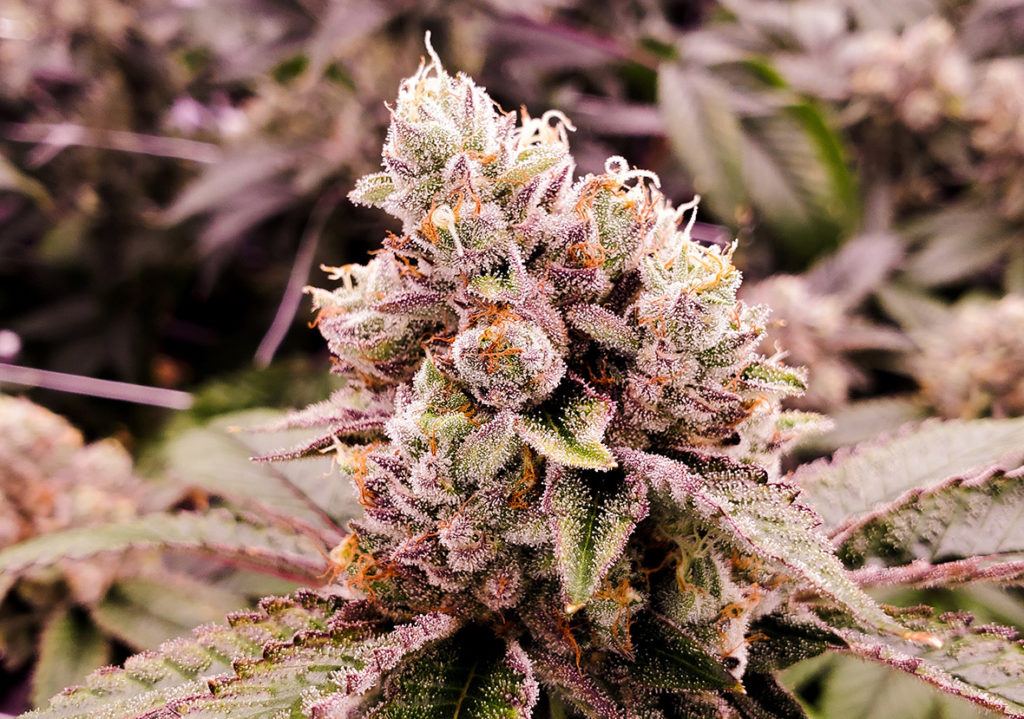With all the focus on THC and CBD, very little attention has been paid to the importance of flavonoids, one of the main compounds in the cannabis plant. Flavonoids are also found in many flowers, fruits, vegetables, herbs and other plant products. In this article, I will define flavonoids, list the six different types of flavonoids with their medicinal properties and food sources, explain the role they play and discuss their potential health benefits. I will classify the cannabis flavonoids and will explain how they protect cannabis plants from pests and bacteria and provide pigmentation for different strains.
What Are Flavonoids?

Flavonoids are a group of plant chemicals found in most fruits and vegetables with antioxidant properties that produce health benefits through cell signaling pathways. There are six different types of flavonoid compounds and each is broken down differently by the human body. They include:
1. Flavonols have antioxidant properties that protect your body from free radicals and other toxins. They are also known for their anti-inflammatory and antihistamine properties. Food sources include leeks, Brussels sprouts, broccoli, onions, kale, apples, berries, teas and beans.
2. Flavones have antioxidant and anti-inflammatory properties. Food sources include hot peppers, celery, parsley and various herbs.
3. Flavanones have anti-inflammatory and antioxidant properties, associated with relaxation and cardiovascular health. Food sources are citrus fruits.
4. Anthocyanins are a subgroup of bioflavonoid phytochemicals responsible for pigmentation, have antioxidant properties, help manage cardiovascular health and prevent diabetes and obesity. Food sources include pomegranates, red and purple grapes, red, blue and purple berries, plums and red wine. Historically, plants with high amounts of anthocyanins have been used in herbal medicines for thousands of years in China, Europe and North America.
5. Isoflavones are phytoestrogens that may play a role in reducing the risk of hormonal cancers; endometrial, breast and prostate cancer and may treat menopausal symptoms. Food sources include soybeans and other soy products and legumes.
6. Flavan-3-ols include monomers, dimers and polymers, have cardiopreventive and neuroprotective properties and may aid in relieving chronic fatigue syndrome symptoms. Food sources include teas, apples, cocoa, grapes, berries, red wine and fava beans.
The Role of Flavonoids

- Have strong antioxidant properties which help to regulate cellular activity by protecting the body from free radicals responsible for oxidative stress. This allows body systems to operate more productively.
- Contain powerful anti-inflammatory properties which may mitigate the body’s inflammatory response with a reduction in symptoms. Toxins, allergens, bacteria and other irritants can precipitate inflammatory symptoms.
- Responsible for pigmentation which does the following:
1. Through photosynthesis, chlorophyll and other pigments facilitate the absorption of light energy
2. Protects plants from UV ray damage
3. Wards off harmful pests and bacteria
4. Sends out visual signal to attract birds, insects and animals to aid in pollination and the dispersal of seeds.
Potential Health Benefits of Flavonoids
Several research studies have been conducted where participants incorporated foods high in flavonoids into their diet. The results indicate that they may do the following:
- Lower risk for stroke or heart attack by controlling blood pressure
- Lower risk for Type 2 Diabetes
- Help stop cancer cells from multiplying
- Help manage weight and cholesterol levels
- Play a role in balancing hormones
- Provide neurodegenerative disease prevention
- Associated with longevity
Cannabis Flavonoids
Cannabis researchers estimate that up to 10% of the compounds in the cannabis plant come from flavonoids which is approximately 3% of weight in the buds and dried leaves. The types of cannabis flavonoids present in any strain depend on its genetics and pigmentation.
More than twenty flavonoids have been identified in cannabis and those only present in cannabis are called cannaflavins.The majority of cannabis flavonoids are anthoxanthins which are flavones and flavonols, responsible for pigments from white to yellow.
- Flavones which include the cannaflavins A,B and C, vitexin, isovitexin, apigenin, luteolin and orientin
- Flavonols which include kaempferol and quercetin
- Flavan-3-ols which include catechins
Cannabis Strains and Their Colors

Due to the presence of chlorophyll, cannabis plants are green during their growing stage. As seasons change and temperatures drop, chlorophyll production stops. This enables anthocyanins to dominate by presenting colors of red, pink, orange, yellow, blue and purple. Exposure of anthocyanins to different pH levels in the soil affects their color. Low pH, which is acidic, may turn plants red. Neutral pH results in purples. High pH, which is alkaline, results in blues.
A Final Note
While terpenes receive all the credit for providing the different flavors and aromas found in cannabis strains, it is important to note that flavonoids also play a crucial role. Flavonoids are not psychotropic and their synergistic interaction with cannabinoids and terpenes provides the entourage effect, producing many disease fighting properties. Much more research investigating the health benefits of flavonoids is sorely needed!
Sources:
https://www.healthline.com/health/what-are-flavonoids-everything-you-need-to-know
https://www.cannabissciencetech.com/view/beyond-potency-flavonoids-purples-reds-and-blues
https://pubmed.ncbi.nlm.nih.gov/18081206/#:~:text=Flavan-3-ols%20have%20been,health%20effects%20of%20these%20compounds
https://www.sciencedirect.com/topics/agricultural-and-biological-sciences/plant-pigments
https://www.livescience.com/52524-flavonoids.html
https://www.leafly.com/news/cannabis-101/what-are-marijuana-flavonoids


